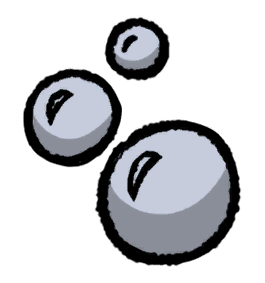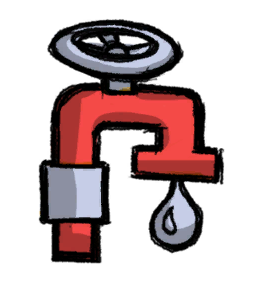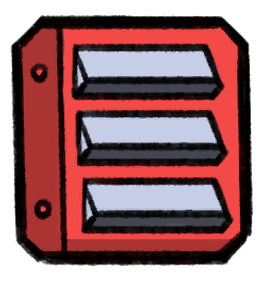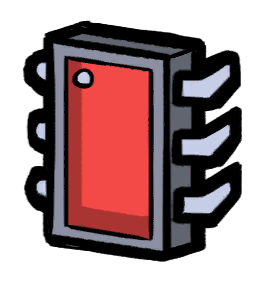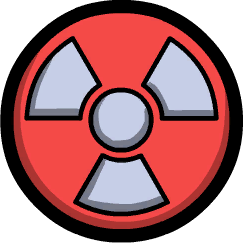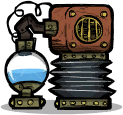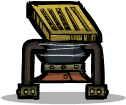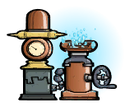Electrolyzer
Electrolyzer is a machine that uses electricity to split Water into its constituent Oxygen and Hydrogen.
Both outputs have a minimum temperature of 70 °C (158 °F) (or higher if the inputs were hotter).
Usage
Electrolyzers require more planning than other oxygen sources as not only do they require water to constantly be supplied via a system of pipes and pumps, but the Hydrogen must also be taken into consideration and handled accordingly. Another aspect is the temperature of the oxygen being created. The Electrolyzer has a minimum output temperature of 70 °C (158 °F), so it is advised to have some form of cooling of the oxygen before using it in the core of the colony. Alternatively have some cooling of or in the colony itself to fight the added heat.
Like its cousin, the Oxygen Diffuser, the Electrolyzer will automatically stop once the four blocks it occupies reach a developer-defined maximum pressure limit.
Electrolyzers may be used to meet a colony's Oxygen needs for as long as there is a source of water. The produced Hydrogen will rise to the top of the room where it can be siphoned off using a Gas Pump. Alternately the electrolysis can be performed in a small air-tight room and Gas Pumps can be employed to carry away the Oxygen and Hydrogen before the room reaches the cut-off pressure. The Hydrogen can then be separated from the Oxygen using a Gas Filter and directed to a Hydrogen Generator to be burnt off, producing a small amount of power in the process. The Oxygen can then be distributed within the colony via Gas Vents. A ventilation system can be used, instead of a single vent, to ensure that there is always a place for the Oxygen to go as an individual vent will stop releasing Oxygen as soon as the block it occupies has reached the pressure limit for that vent. A Geyser may be used to provide an unlimited supply of water for an Electrolyzer-based Oxygen supply.
Heat economy
Consider cooling water as little as possible or even dump some heat into it before delivering into electrolyzers. The input kilogram of water is more heat-dense than output kilogram of gasses, which is convenient, as it makes gasses easier to cool down afterwards.
But it gets better – Using 0 °C as the "base" temperature, 1 kg mix of oxygen and hydrogen at 70 °C carries as much heat as 1 kg of water at 19.45 °C, which means that with 19.75 °C input the electrolyzer starts destroying heat and becomes net heat negative. It will destroy 4.179 kDTU (1kg * the specific heat of water) per every degree above that, until reaching 70 °C where the outputs also begin to rise in temperature and the efficiency drops to around 3kDTUs/degree. With near-boiling 96 °C water it will stack up to 288 kDTU/s in absolute numbers, which is comparable to 3.6 AETNs.
Note, that Electrolyzer will not process water and release steam into the environment if the intake is too hot.
As a corollary, feeding water colder than 19.8 °C will create heat.
That said, the 70 °C output is sure to cook any farm relying on maintaining a temperature of 30 °C or lower without any additional heat transfer/deletion. For each gram of Oxygen it outputs the Electrolyzer outputs mass with a heat capacity of 1.308 (DTU/g)/°C. Given a Duplicant consumes 100g/s Oxygen, cooling the output of an Electrolyzer requires 130.8 (DTU/°C)/s per Duplicant, or for a 40°C difference, 5.2 kDTU/s. This is slightly more heat than is deleted by a fertilized Wheezewort in an Oxygen environment.
Tips
- The Electrolyzer is an Algae-free way of producing Oxygen and should be researched before you run out of Algae.
- Filling the Electrolyzer with anything other than Water will cause damage to it. This limitation includes Polluted Water.
- The Electrolyzer has a 10 kg internal reserve, which lasts for 10 seconds under ideal conditions.
- The Electrolyzer will not remove Food Poisoning or Slimelung germs within the water, and will output the germs with the Oxygen. Both germs will gradually die out in Oxygen.
- Using High Pressure Gas Vents will more efficiently spread oxygen in the base (however too high pressure will cause popped eardrums which give stress, to avoid this use automation to shut off the vent at a sufficiently high pressure below 4kg).
- The Electrolyzer is best combined with the Anti Entropy Thermo-Nullifier to cool down its output for very little cost in Hydrogen. In addition, it can prevent the Electrolyzer from heating too much if built close enough.
Bugs
Placing the Electrolyzer with two Gas Pumps on the left and right side, in the sealed room 6x2, will result in significant amount of hydrogen disappear, effectively producing only 75 g/s of hydrogen (about 66% of what it should be). The workaround is to make the room 3 tiles high (with pumps and electrolyzer placed on the ground).
Trivia
The tooltip is a reference to the movie "Cloudy with a Chance of Meatballs", in which a machine is invented that can turn water, into food.



